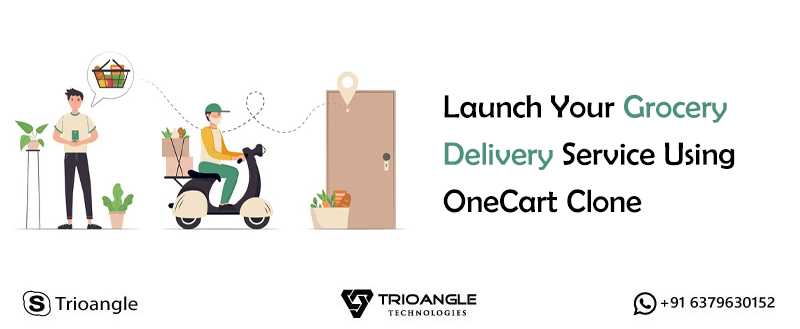Groceries have become a part of our daily activities. Ordering them via online mode sets a new trend. As an entrepreneur or business owner, one thing you may understand launching an online grocery delivery service is risk-free and demandable.
Did you know? Many data scientists predicted online grocery delivery services would rise to around $200 billion by 2025.
- In the US, tens of millions of consumers use online grocery services for the first time.
- By 2022, almost 10% of all grocery sales will happen through online smartphones.
- 5% of consumers order groceries items online twice a month.
After seeing these statistics, still why are waiting to launch a grocery delivery service?
Even though there are many grocery delivery scripts available in the market. OneCart Clone is best.
Before designing OneCart Clone, you need to finalize your business interface & revenue models using our blog. Let’s dive into it.
Business Interface of OneCart Clone:
In OneCart Clone, there is four main business interface that exists in OneCart Clone. They are listed below:
- Buyers
- Seller/vendor
- Delivery Partners
- Admin
Buyers:
Buyers browse groceries items based on preferred geo locations, categories and prices. Also, can they change their location manually by updating their Pincode to the cart and ordering their groceries items using this interface.
Easy to log in:
Providing a great user experience to your buyers makes them feel happy and comfortable. To make it easy and simple, you need to come up with simplified login options for your OneCart Clone app. This helps them to use your grocery delivery app without any hassle.
Schedule Grocery Order:
To make your customers convenient, you can provide order scheduling options to them. Using this, your buyers can schedule the grocery orders as per the desired time.
Seller/vendor:
Sellers create and manage grocery stores smooth & efficient by using this interface. They view customers’ orders and raise withdrawal requests and handle cancellations. Also, sellers can adjust the prices and estimated arrival times for zone-based delivery services using this seller interface.
Modern Payment System:
As a seller, you need to know the customer’s expectations in paying for your products. To fulfil their expectation, you can accept multiple payment gateways using the modern payment system. This helps the customers to pay digitally like debit, credit cards or even in crypto wallet etc.
Availability of Stores:
As a store owner, you can change your status of the store to open or close. If the status is open, then you can accept your customer’s grocery orders. Or else it is closed, then customers can’t able to order from your grocery store.
Delivery Partners:
Delivery partners accept or decline the grocery order requests and delivered their orders to the customer’s doorstep. Using this interface, the delivery partners find out which are orders to be delivered a day. Also, they can know the total number of orders to be delivered via dedicated history. Besides, the following features make their workflow to be smart.
Location Tracking:
With the help of a location tracker, delivery partners can able to find the shortest distance to deliver the ordered grocery items to customers. This helps them to reach customers’ doorstep faster and be able to handle multiple orders at the same time.
Push Alerts:
Once the customers order the grocery items, this push alert feature sends the instant notification to the delivery partners to accept or reject the grocery orders. Based on their decision, they can choose the options. Also, they can get any updates from admin or store owners.
Admin:
Admin use to control over all things in the panel. This helps to manage all products in the grocery’s inventories, shops, payments and more. Also, the admin can define the commission for delivery services from the admin interface.
Easy to Manage:
Here, the admin has an exclusive profile management system that helps to create and manage user profiles for the online grocery delivery apps. Also, they can able to manage easily all activities in store owners, delivery partners etc.
Filter Top Reviews:
This trusted review system helps the admin to filter the top-rated review from delivery partners. Using this, the admin can find the best performer in delivery service and be able to push up in front of your customers.
Revenue Model of OneCart Clone:
The delivery commission will shortly be transferred to the virtual wallet and transferred to the delivery partner’s bank account when they raised a withdrawal request using this interface.
- Listing Fees – Here, the admin can charge the grocery sellers for listing their groceries items in your online delivery app.
- Paid Ads Subscription – Since there is heavy competition among grocery owners. Sellers can be paid to admin for exclusive promotions like featured ads banners in your app.
- Commission on Each Delivery – Once the grocery order is completed, the admin can charge both customer and delivery partners with some amount of money based on the distance parameters.
Summing Up:
Till now, you might be aware of the golden points of OneCart clone app-based grocery delivery services. The details like the business & revenue model illustrated in this blog make you aware of the interfaces, features and ways to generate revenue in detail. This detailed concept of grocery delivery services using OneCart Clone makes you eager to launch your business. Wish to launch the special app for yourself? Then, free feel to contact us:
Mail: [email protected]
WhatsApp: +91 6379630152
Skype: Trioangle
OneCart Clone: https://www.trioangle.com/onecart-clone/


